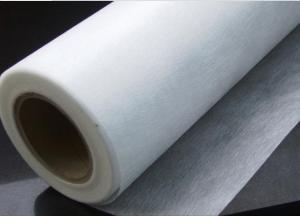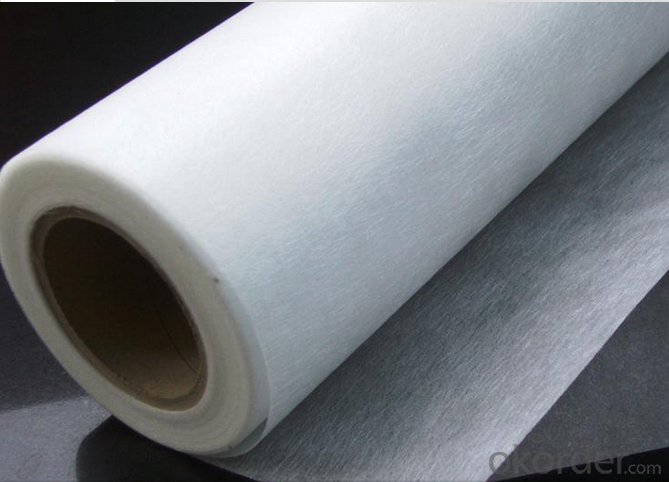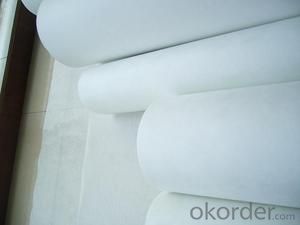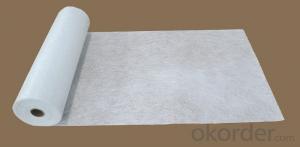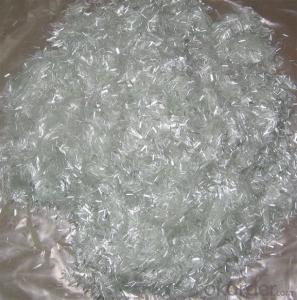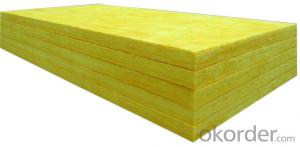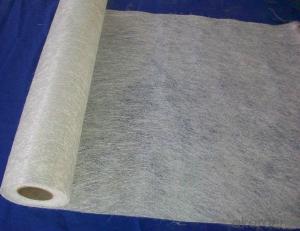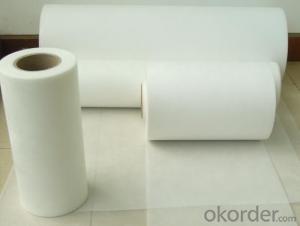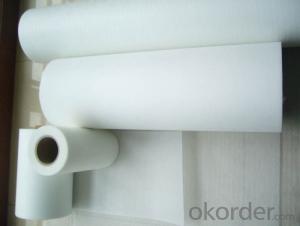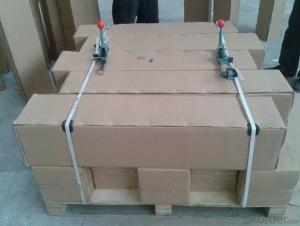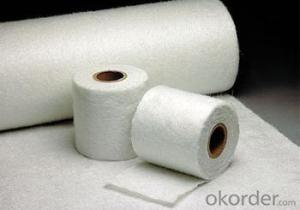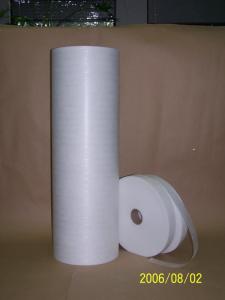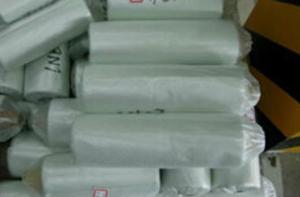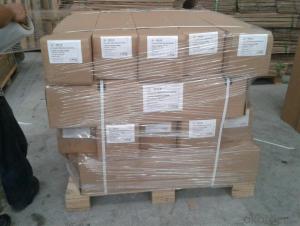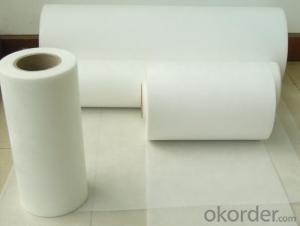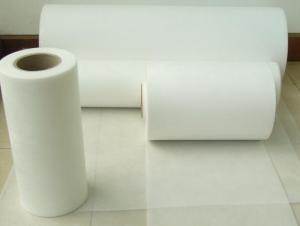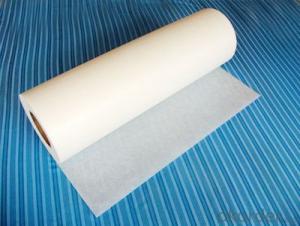Fiberglass Mat Tissue e-glass Fiber Surface Tissuing Mat for GRP
- Loading Port:
- Qingdao
- Payment Terms:
- TT or LC
- Min Order Qty:
- 72000 m²
- Supply Capability:
- 1440000 m²/month
OKorder Service Pledge
OKorder Financial Service
You Might Also Like
Surfacing Tissue mainly used in the surface layers of FRP products. It features even Fiber distribution, soft feel, level and smooth fiber surface, less glue content, quick resin soak and good pattern fitness. It can improve the product surface property on corrosion resistance, compressive strength, seepage resistance, and longer service life. It is also suitable for spraying; pattern pressing and other FRP pattern technology.
Product Features:
Fast breakdown in styrene
Fiber dispersed evenly
Low binder content
Superior acid corrosion resistance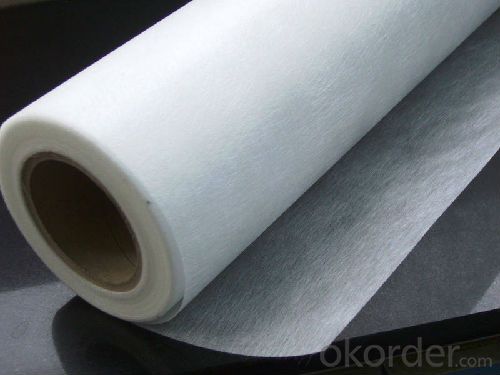
Specifications:
Item | Unit | Specification |
Area Weight | g/m2 | 30+/-3 |
Binder Content | % | 6-9 |
Tensile Strength MD | N/125px | ≥35 |
Soaking time | S | ≤10 |
Moisture content | % | ≤0.5 |
Width length
| mm
| 1270
|
Roll Diameter
| m | 300
|
Paper Core Internal Dia | mm | 76 |
Special specification can be produce according to customer requirements.
Product packaging:
Each Surface Tissue is wound onto a paper tube The mat roll is wrapped up with plastic film,and then packed in a cardboard box or wrapped up with kraft paper. The rolls can be vertically or horizontally placed. For transportation, the rolls can be loaded into a cantainer directly or on pallets.
Product storage:
Unless otherwise specified, Chopped Strand Mat should be stored in a dry, cool and rain-proof area.
- Q: Is fiberglass mat tissue suitable for outdoor applications?
- Indeed, outdoor applications are well-suited for fiberglass mat tissue. This particular material is constructed from interwoven fiberglass strands, all effectively bound together by a specialized adhesive. Its exceptional resistance to water, weather, and UV radiation renders it particularly well-suited for deployment in outdoor settings. Its adaptability extends to a range of outdoor applications, including roofing, insulation, and construction projects. The waterproof and weatherproof qualities of fiberglass mat tissue guarantee its robustness and longevity even in the face of harsh environmental conditions. Moreover, its lightweight nature and user-friendly handling characteristics make it a highly versatile option for various outdoor endeavors.
- Q: What is the moisture resistance of fiberglass mat tissue?
- The moisture resistance of fiberglass mat tissue is high.
- Q: Can fiberglass mat tissue be used for insulation in chemical storage tanks?
- Yes, fiberglass mat tissue can be used for insulation in chemical storage tanks. It is a commonly used material due to its excellent thermal insulation properties and resistance to corrosion, making it suitable for protecting the tank and its contents from extreme temperatures and chemical reactions.
- Q: Is fiberglass mat tissue resistant to UV degradation?
- Fiberglass mat tissue is generally resistant to UV degradation to some extent. However, its level of resistance may vary depending on the specific type and quality of the fiberglass mat tissue. UV degradation occurs when prolonged exposure to ultraviolet (UV) radiation from the sun causes the degradation of materials. This degradation can lead to discoloration, brittleness, and reduced strength in the material. Fiberglass mat tissue is often manufactured with additives and coatings that provide some level of UV resistance. These additives and coatings help to protect the fibers from the damaging effects of UV radiation. However, it is important to note that the level of UV resistance can vary between different manufacturers and products. To ensure maximum UV resistance, it is recommended to choose fiberglass mat tissue that is specifically designed for outdoor applications and has been tested for UV stability. Additionally, proper maintenance and periodic inspections can help to identify any signs of UV degradation and allow for timely repairs or replacements if necessary.
- Q: Does fiberglass mat tissue provide any UV resistance?
- Indeed, some degree of UV resistance is typically offered by fiberglass mat tissue. Comprised of glass fibers embedded in a resin matrix, this material provides a certain level of safeguard against UV radiation emitted by the sun. Nevertheless, it should be emphasized that the extent of UV resistance may differ based on the precise composition and manufacturing procedure of the fiberglass mat tissue. Furthermore, extended exposure to UV radiation can still result in gradual deterioration. Therefore, it is advisable to implement suitable measures, such as employing UV-resistant coatings or finishes, to augment the longevity and resilience of fiberglass mat tissue when utilized outdoors.
- Q: What is the tear strength of fiberglass mat tissue?
- The tear strength of fiberglass mat tissue refers to the ability of the material to resist the propagation of tears or cracks when subjected to external forces. It is a crucial characteristic that determines the durability and performance of fiberglass mat tissue in various applications. The tear strength of fiberglass mat tissue is typically measured using standardized testing methods, such as the ASTM D1922 tear resistance test. This test involves subjecting a sample of the material to a controlled force, typically in the form of a tensile load, and measuring the force required to cause a tear or rupture. The tear strength of fiberglass mat tissue can vary depending on factors such as the manufacturing process, the quality of the raw materials used, and the specific application requirements. Generally, fiberglass mat tissues are designed to have high tear strength to withstand the stresses and strains encountered during installation and use. Fiberglass mat tissue is commonly used in industries such as construction, automotive, aerospace, and marine, where its high tear strength and other desirable properties make it an ideal choice. It is often utilized as a reinforcement material in composites, providing added strength and durability to the final product. In conclusion, the tear strength of fiberglass mat tissue is an important property that determines its resistance to tearing or cracking under applied forces. By ensuring a high tear strength, fiberglass mat tissue can withstand the demands of various applications and provide long-lasting performance.
- Q: How does fiberglass mat tissue compare to polystyrene insulation?
- Fiberglass mat tissue and polystyrene insulation are two different materials used for insulation purposes, and they have their own distinct characteristics and benefits. Fiberglass mat tissue is made from thin strands of glass fibers that are woven together to form a mat. It is commonly used in applications where heat and sound insulation is required. Fiberglass mat tissue is known for its excellent thermal insulation properties, as it can effectively resist heat transfer, making it suitable for both hot and cold environments. Additionally, it is resistant to moisture and does not promote the growth of mold or mildew. On the other hand, polystyrene insulation is a foam material made from expanded polystyrene beads. It is widely used in the construction industry as it provides good thermal insulation and can be easily shaped or cut to fit various spaces. Polystyrene insulation is known for its high compressive strength, making it ideal for load-bearing applications. It is also moisture-resistant, lightweight, and has excellent resistance to aging and degradation. When comparing fiberglass mat tissue to polystyrene insulation, there are a few key differences to consider. Fiberglass mat tissue is generally more flexible and can be easier to install in irregular or curved surfaces. It is also more resistant to fire, as it does not burn or release toxic gases when exposed to flames. However, fiberglass mat tissue can be more expensive than polystyrene insulation and may require additional protective measures, such as wearing gloves and masks during installation, due to its potential for skin and respiratory irritation. Polystyrene insulation, on the other hand, is less expensive and easier to handle and install compared to fiberglass mat tissue. It also has better moisture resistance, which makes it suitable for applications in areas with high humidity or potential water exposure. However, polystyrene insulation is more flammable than fiberglass mat tissue and can release toxic gases when burned. In conclusion, the choice between fiberglass mat tissue and polystyrene insulation depends on the specific requirements of the insulation project. Fiberglass mat tissue is well-suited for its excellent thermal insulation properties, fire resistance, and resistance to moisture and mold. Polystyrene insulation, on the other hand, offers good thermal insulation, ease of installation, and high compressive strength. Ultimately, it is important to consider factors such as cost, installation requirements, fire resistance, and moisture resistance when deciding between fiberglass mat tissue and polystyrene insulation.
- Q: Can fiberglass mat tissue be used for acoustic panels?
- Acoustic panels can utilize fiberglass mat tissue for sound absorption. This lightweight material is commonly employed for insulation purposes and is known for its exceptional sound-absorbing properties. By effectively reducing noise levels, it enhances the functionality of acoustic panels. Moreover, fiberglass mat tissue is a preferred choice for DIY projects due to its ease of use. However, it is crucial to consider other factors such as panel design, thickness, density, and installation method to maximize the effectiveness of acoustic panels. Therefore, consulting experts or conducting thorough research is recommended to determine if fiberglass mat tissue is suitable for your specific acoustic panel requirements.
- Q: Can fiberglass mat tissue be used for making lightweight automotive parts?
- Fiberglass mat tissue is indeed suitable for creating lightweight automotive parts. This material, known for its versatility, is widely used in the manufacturing process of automotive components. It boasts an impressive strength-to-weight ratio, making it perfect for producing durable and high-performing lightweight parts. Furthermore, the ease with which fiberglass mat tissue can be molded into different shapes allows for intricate and customized automotive designs. Its notable resistance to corrosion, chemicals, and temperature changes only adds to its suitability for automotive applications. In conclusion, fiberglass mat tissue is a dependable and cost-efficient option for crafting lightweight automotive parts.
- Q: What are the different reinforcement patterns available for fiberglass mat tissue?
- Fiberglass mat tissue offers various reinforcement patterns, each with its unique benefits and characteristics. 1. Random Chopped Strand Mat (CSM) is widely utilized and consists of randomly chopped fiberglass strands held together with a binder. It boasts good strength and stiffness properties, making it suitable for a wide range of applications. 2. Continuous Strand Mat (CSM) features evenly distributed continuous fiberglass strands bound together with a binder. It offers enhanced strength and stiffness compared to random chopped strand mat, making it perfect for high-performance applications. 3. Woven Roving comprises interwoven bundles of fiberglass yarns and provides exceptional strength and impact resistance. It is ideal for applications that require high load-bearing capabilities. 4. Multiaxial Fabrics consist of multiple layers of fiberglass fibers oriented in different directions, offering balanced strength properties in multiple directions. This makes it perfect for applications that require isotropic properties. 5. Stitch-Bonded Fabrics are created by mechanically stitching together layers of fiberglass fibers. They offer good drapability and conformability, making them suitable for complex shapes or curved surfaces. 6. Knitted Fabrics are made by interlocking loops of fiberglass yarns, providing excellent flexibility and ease of handling. They are suitable for applications that require conformability and flexibility. Each reinforcement pattern possesses its own advantages and is utilized in various applications based on specific requirements such as strength, stiffness, impact resistance, flexibility, or conformability. It is crucial to select the appropriate reinforcement pattern based on desired end-use properties and the manufacturing process.
Send your message to us
Fiberglass Mat Tissue e-glass Fiber Surface Tissuing Mat for GRP
- Loading Port:
- Qingdao
- Payment Terms:
- TT or LC
- Min Order Qty:
- 72000 m²
- Supply Capability:
- 1440000 m²/month
OKorder Service Pledge
OKorder Financial Service
Similar products
Hot products
Hot Searches
Related keywords
